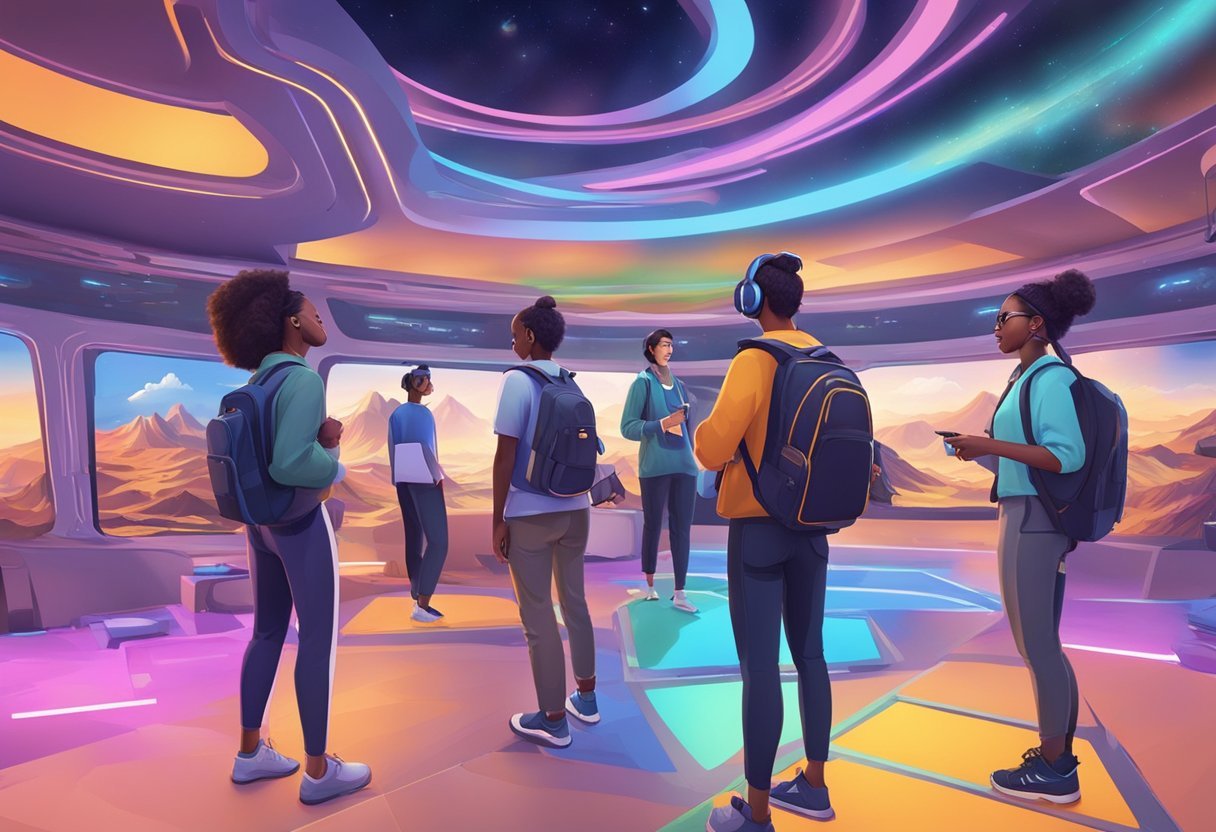The metaverse and AI have been hot topics in the tech world for years, but they’re now gaining more attention than ever before. The metaverse is a virtual world where people can interact with each other and their surroundings in real-time. It’s a new form of experience that combines technology and human interaction. AI is a powerful tool that can help create and manage the metaverse, making it a more immersive and personalized experience for users.
The metaverse is still in its infancy, but it’s growing rapidly. It’s being developed by major tech companies like Facebook, Google, and Amazon, who are investing billions of dollars in the technology. AI is also playing an important role in the development of the metaverse. It can help create realistic environments, generate content, and personalize the experience for each user. With the help of AI, the metaverse could become a truly immersive experience that feels like a real-world environment.
These technologies are still evolving, but they have the potential to change the way we interact with each other and our surroundings. The metaverse and AI could create new opportunities for businesses, entertainment, and social interaction. As the technology develops, it will be interesting to see how it will be used and how it will change the way we live our lives.
Defining the Metaverse and AI
Virtual worlds have been around for decades, but the concept of the metaverse is relatively new. The metaverse is a collective virtual shared space that is created by the convergence of multiple virtual worlds. It is a fully immersive digital environment that allows users to interact with each other and digital objects in real-time. The metaverse is expected to revolutionize the way we interact with each other and the digital world.
The evolution of virtual worlds has been driven by advancements in technology, such as virtual reality (VR) and augmented reality (AR). VR provides a fully immersive experience by blocking out the real world and replacing it with a simulated environment. AR, on the other hand, overlays digital content onto the real world. The combination of these technologies has paved the way for the development of the metaverse.
Role of AI in the Metaverse
Artificial intelligence (AI) is a foundational pillar for building the metaverse. AI can play a significant role in the future of the metaverse, not only from a product perspective but also considering how AI can enhance the user experience. AI can be used to create more realistic and intelligent virtual characters, provide personalized recommendations, and optimize virtual environments.
One of the most significant benefits of AI in the metaverse is its ability to create generative content. Generative content is content that is created by AI algorithms rather than humans. This means that the metaverse can generate an infinite amount of content, which can keep users engaged for longer periods. AI can be used to create more immersive and interactive experiences, which can enhance the user experience.
The metaverse is a fully immersive digital environment that is created by the convergence of multiple virtual worlds. AI is a foundational pillar for building the metaverse and can play a significant role in enhancing the user experience. The combination of these technologies has the potential to revolutionize the way we interact with each other and the digital world.
Computing Infrastructure
The metaverse requires a significant amount of computing power to function properly. The computing infrastructure that powers the metaverse is a complex system of interconnected servers, data centers, and networks. High-performance computing (HPC) is essential to the operation of the metaverse, and AI supercomputers such as NVIDIA’s DGX A100 are becoming increasingly important in the development of the metaverse.
These supercomputers are capable of performing complex calculations and running deep learning algorithms that are necessary to create realistic and immersive virtual environments.
AR and VR Technologies
Augmented reality (AR) and virtual reality (VR) technologies are essential components of the metaverse. AR and VR technologies enable users to interact with the metaverse in a more immersive and engaging way.
AR technologies overlay digital information onto the physical world, while VR technologies create entirely new virtual environments. These technologies are constantly evolving, and new advancements in AR and VR are being made all the time.
AI and Machine Learning
AI and machine learning are crucial components of the metaverse. AI algorithms are used to create realistic and intelligent virtual characters, while machine learning is used to create realistic and dynamic virtual environments. Generative AI, in particular, is becoming increasingly important in the development of the metaverse. Generative AI algorithms are capable of creating new content automatically by utilizing input data. This is particularly useful for creating high-quality content for the metaverse, as the content required by the metaverse is hard to create.
The technological foundations of the metaverse are complex and constantly evolving. Computing infrastructure, AR and VR technologies, and AI and machine learning are all essential components of the metaverse. As the metaverse continues to develop, it is likely that new technologies will emerge that will further enhance the user experience.

Metaverse -AI Experiences
The metaverse is a virtual world that is designed to offer immersive experiences. It is a place where people can interact with each other, explore new environments, and engage in various activities. Artificial intelligence (AI) is an essential component of the metaverse, as it enables the creation of realistic and interactive environments.
Immersive Environments
One of the most significant advantages of the metaverse is the ability to create immersive environments. These environments are designed to simulate real-world experiences, allowing users to feel as if they are actually there. Immersive environments can be created using a combination of 3D objects, digital twins, and simulations. AI can be used to create realistic physics simulations, which can enhance the immersion factor of the environment.
Digital Twins and Simulations
Digital twins and simulations are essential components of the metaverse. They enable the creation of virtual versions of real-world objects and environments. These digital twins can be used to simulate real-world scenarios and test various hypotheses. AI can be used to create intelligent simulations that can adapt to changing conditions and provide realistic feedback.
Interactivity and 3D Content
Interactivity and 3D content are critical elements of the metaverse. Users can interact with each other and with the environment, creating a sense of presence and immersion. 3D content can be used to create realistic environments, objects, and characters. AI can be used to create intelligent agents that can interact with users and provide realistic feedback.
The metaverse offers a unique opportunity to create immersive experiences using AI, digital twins, and simulations. The ability to interact with the environment and other users creates a sense of presence that is not possible with traditional media. As AI technology continues to improve, the metaverse will become even more realistic and engaging.
AI-Driven Content and Services in the Metaverse
The metaverse is a promising arena for AI to thrive. AI can be used to create content, services, and experiences that are immersive, engaging, and personalized. In this section, we will explore some of the ways AI can be used to drive content and services in the metaverse.
Generative AI
Generative AI is a subfield of AI that involves using machine learning algorithms to generate new content, such as images, videos, and text. In the metaverse, generative AI can be used to create unique and personalized experiences for users.
For example, generative AI can be used to create custom avatars for users based on their preferences and characteristics. It can also be used to generate personalized content, such as news articles, social media posts, and product recommendations.
Natural Language Processing
Natural Language Processing (NLP) is another subfield of AI that involves analyzing and understanding human language. In the metaverse, NLP can be used to enhance communication between users and AI-driven assistants.
For example, NLP can be used to create chatbots that can understand and respond to user queries in natural language. It can also be used to create voice assistants that can interact with users in a more natural and intuitive way.
AI Assistants and Chatbots
AI assistants and chatbots are becoming increasingly popular in the metaverse. They can be used to provide users with personalized assistance, such as helping them navigate virtual environments, find information, and make purchases. AI assistants and chatbots can also be used to enhance social interactions between users. For example, they can be used to facilitate conversations between users who speak different languages or have different communication preferences.
AI has the potential to revolutionize the way content and services are created and delivered in the metaverse. By leveraging technologies such as generative AI, NLP, and AI assistants, developers can create immersive and engaging experiences that are tailored to the needs and preferences of individual users.
Metaverse for Business and Enterprise
The metaverse presents a world of opportunities for businesses across industries, from gaming to real estate to retail. With the integration of AI, it becomes even more powerful. In this section, we will explore some of the applications of the metaverse in the business and enterprise world.
Enterprise Metaverse Applications
The enterprise metaverse is a digital and immersive environment that replicates and connects every aspect of an organization to optimize experiences and decision-making. Digital twins are at the core of the enterprise metaverse, and they enable businesses to create virtual models of their products, services, and operations. These models can then be used to test, optimize, and simulate different scenarios before implementing them in the real world.
In addition to digital twins, AI-driven assistants can facilitate seamless interactions within the metaverse, providing users with instant information and optimizing user movement. Navigation tools powered by AI can help users find their way around the metaverse, making it easier to explore and interact with the environment.
Industrial and Real Estate Innovations
The metaverse is also a powerful tool for innovation in the industrial and real estate sectors. For example, the development of digital twins can help industrial companies optimize their production processes, reduce costs, and improve product quality. By creating virtual models of their factories and equipment, companies can simulate different scenarios and identify potential issues before they occur.
In the real estate sector, the metaverse can be used to create virtual models of properties, allowing potential buyers and renters to explore and experience them before making a purchase or signing a lease. This can save time and money for both buyers and sellers, as well as reduce the need for physical visits.
The metaverse and AI are a powerful combination for businesses and enterprises looking to innovate and optimize their operations. By leveraging the capabilities of the metaverse and AI, businesses can create virtual models of their products, services, and operations, optimize their processes, and create more engaging and immersive experiences for their customers.

Social and Cultural Impact
The metaverse is an immersive virtual space that has the potential to revolutionize the way people interact with each other. With the help of AI, the metaverse can create virtual communities where people can connect with each other in ways that were previously impossible.
Virtual Communities
Virtual communities are a key feature of the metaverse. They allow people from all over the world to connect with each other and form relationships that transcend geographical boundaries. These communities can be based on common interests, hobbies, or even political beliefs. The metaverse provides a platform for people to come together and engage in meaningful discussions and collaborations.
Second Life, a virtual world that was launched in 2003, is an example of a successful virtual community. It has over a million active users who engage in various activities such as gaming, socializing, and even attending virtual concerts. The pandemic has further increased the popularity of virtual communities as people seek alternative ways to connect with others.
Creative and Collaborative Spaces
The metaverse also offers creative and collaborative spaces where people can come together to work on projects, share ideas, and create new things. These spaces can be used for anything from designing new products to creating art installations.
The metaverse has the potential to democratize creativity by providing a platform for people from all walks of life to showcase their talents. This can lead to a more diverse and inclusive creative industry.
Mark Zuckerberg, the CEO of Facebook, has expressed his vision for the metaverse as a place where people can work, play, and create. However, there are concerns about the dystopian implications of a world where people spend more time in virtual reality than in the real world. It is important to consider the social and cultural impact of the metaverse and ensure that it is used in a responsible and ethical manner.
Challenges and Future Directions
Interoperability and Standards
One of the major challenges for the development of the Metaverse is interoperability and standards. The Metaverse is expected to be a vast network of interconnected virtual worlds, and the lack of interoperability and standards could result in a fragmented and isolated Metaverse.
To ensure a seamless experience for users, it is essential to establish interoperability and standards that enable the exchange of data and assets across different virtual worlds and platforms.
The development of a universal speech translator is a breakthrough that could help address the issue of interoperability. A universal speech translator could enable users to communicate with each other across different virtual worlds and platforms, regardless of language barriers.
Self-supervised learning could be used to develop intelligent agents that can navigate and interact with different virtual worlds and platforms, further enhancing interoperability.
Ethical and Privacy Concerns
As with any emerging technology, the development of the Metaverse raises ethical and privacy concerns. The Metaverse will collect vast amounts of data on users, including their behavior, preferences, and interactions. This data could be used to develop highly targeted advertising and marketing campaigns, but it could also be used for more nefarious purposes, such as surveillance or identity theft.
To address these concerns, it is essential to establish ethical and privacy standards that protect user data and ensure transparency in the collection and use of data. The development of infrastructure that prioritizes user privacy and security is also crucial. As the Metaverse continues to evolve, it will be essential to monitor and adapt to new ethical and privacy concerns that arise.
The development of the Metaverse presents both opportunities and challenges. Interoperability and standards, along with ethical and privacy concerns, are two of the most significant challenges that must be addressed to ensure the success of the Metaverse. By prioritizing these challenges and working to develop solutions, the Metaverse can become a truly immersive and inclusive virtual world.
Frequently Asked Questions
Does the Metaverse use AI?
Yes, AI is an essential component of the Metaverse. It is used to create realistic digital avatars, simulate physical and emotional characteristics, and enhance user experiences. AI enables the Metaverse to provide a more immersive and interactive environment for users.
What are the challenges of AI in the Metaverse?
One of the significant challenges of AI in the Metaverse is ensuring that it is ethical and transparent. There is a risk of AI being used to manipulate user behavior and data, which could lead to privacy concerns. There is a need to ensure that AI algorithms are secure and free from bias.
What is the role of AI in virtual worlds?
AI plays a crucial role in creating and managing virtual worlds. It is used to generate content, simulate physics, and create realistic environments. AI also helps to enhance user experiences by providing personalized recommendations and improving interaction with virtual objects.
Can the Metaverse replace reality?
No, the Metaverse cannot replace reality. It is a virtual world that provides a different experience from the physical world. While the Metaverse can offer a more immersive and interactive environment, it cannot provide the same sensory experiences as the physical world.
How does AI contribute to the development of the Metaverse?
AI contributes to the development of the Metaverse by providing advanced technologies that enhance user experiences. AI is used to create realistic digital avatars, simulate physical and emotional characteristics, and provide personalized recommendations. AI also helps to generate content and create realistic environments.
What are the potential challenges when integrating AI within the Metaverse?
Integrating AI within the Metaverse poses several challenges, including ensuring that AI algorithms are secure and free from bias. There is also a need to ensure that AI is used ethically and transparently and that users’ privacy is protected. There is a need to ensure that AI is compatible with existing technologies and platforms.
In what ways can generative AI impact user experiences in the Metaverse?
Generative AI can impact user experiences in the Metaverse by providing personalized content and recommendations. It can also help to create unique and immersive environments that are tailored to individual users’ preferences. Generative AI can be used to create realistic digital avatars and simulate physical and emotional characteristics.
What are the emerging AI-driven projects shaping the future of the Metaverse?
There are several emerging AI-driven projects shaping the future of the Metaverse. These include projects focused on creating realistic digital avatars, improving user experiences, and developing advanced AI algorithms. There are projects focused on ensuring that AI is used ethically and transparently and that users’ privacy is protected.
How might AI change the way we interact with virtual worlds in the Metaverse?
AI has the potential to change the way we interact with virtual worlds in the Metaverse by providing more immersive and interactive experiences. AI can be used to create realistic digital avatars, simulate physical and emotional characteristics, and provide personalized recommendations. AI can be used to create unique and immersive environments that are tailored to individual users’ preferences.
Can the Metaverse realistically simulate aspects of reality through advancements in AI?
Yes, the Metaverse can realistically simulate aspects of reality through advancements in AI. AI can be used to create realistic digital avatars, simulate physical and emotional characteristics, and provide personalized recommendations. AI can be used to create unique and immersive environments that are tailored to individual users’ preferences.




